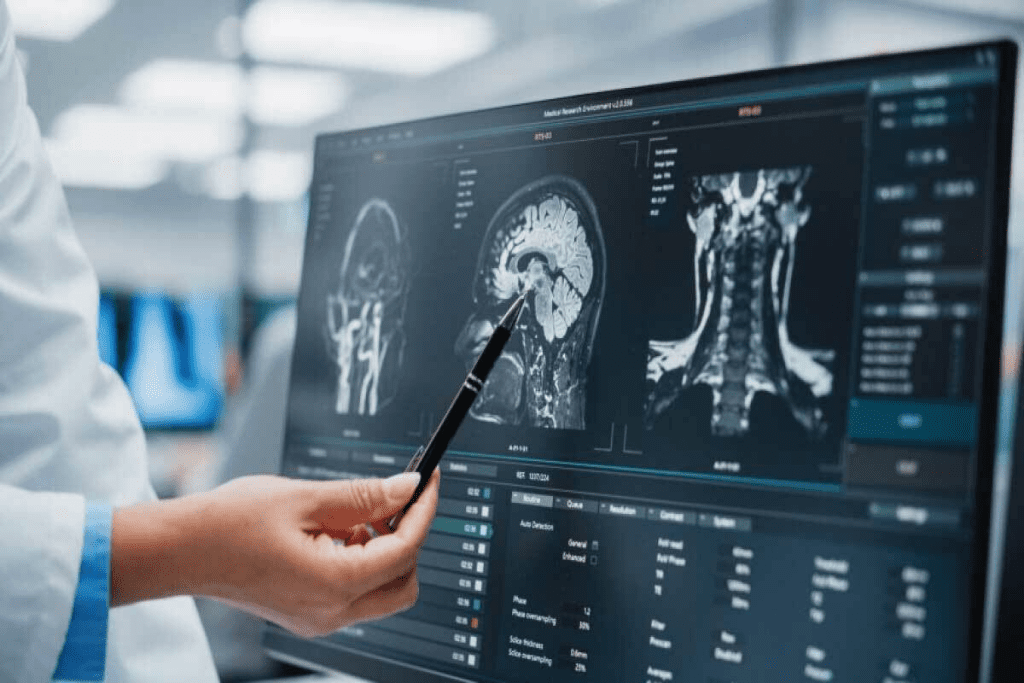Last Updated on November 27, 2025 by Bilal Hasdemir

Going through brain tumor removal surgery can feel overwhelming. It’s a complex process that requires expert planning, precision, and the use of advanced medical technology.
The success of brain tumor removal surgery depends on several factors, including the tumor’s type, size, and location, as well as the patient’s overall health and the surgeon’s experience.
At Liv Hospital, we’re committed to delivering top-quality healthcare. Our neurosurgery team provides complete support and guidance to patients from around the world, ensuring the safest and most effective outcomes possible.
Key Takeaways
- Understanding the complexity of brain tumor removal surgery.
- The importance of a skilled medical team in neurosurgery.
- Factors influencing the success of brain tumor surgery.
- Advanced technology is used in brain tumor removal procedures.
- Comprehensive support for international patients undergoing neurosurgery.
Understanding Brain Tumors

Brain tumors are complex and varied. They need a detailed approach for diagnosis and treatment. We will look at the different types of brain tumors, their grading, and how their location affects surgery.
Primary vs. Metastatic Brain Tumors
Brain tumors are divided into two main types: primary and metastatic. Primary brain tumors start in the brain. Metastatic brain tumors come from other parts of the body. Knowing where the tumor comes from is key to the best treatment.
The difference between primary and metastatic tumors is big. It affects treatment choices and how well a patient might do. Primary tumors can be benign or malignant and are graded based on cell type and grade. Metastatic tumors are always malignant and need a team effort for treatment.
Tumor Grading and Classification
Tumor grading is very important for planning treatment and predicting outcomes. The World Health Organization (WHO) grading system is used. It ranges from Grade I (least aggressive) to Grade IV (most aggressive).
The grading is based on the tumor’s appearance under a microscope. This includes how different the cells are, how fast they divide, and if there’s blood vessel growth or cell death.
- Grade I: Usually benign and grows slowly, often can be cured with surgery.
- Grade II: Grows slowly but can turn into higher grades.
- Grade III: Malignant, grows faster, and can get even worse.
- Grade IV: The most aggressive and malignant, with a poor outlook.
Location Considerations and Surgical Accessibility
The spot where a brain tumor is located is very important for surgery. Tumors in eloquent areas of the brain, like those controlling speech or movement, need careful surgery to avoid harm. New imaging and monitoring tools help remove tumors while keeping brain function safe.
How easy it is to reach a tumor also matters. Tumors deep in the brain or near important structures might need special surgery or other treatments.
Patient Selection for Brain Tumor Surgery

Choosing to do brain tumor surgery depends on a detailed look at the patient and the tumor. We look at many things to find the best treatment for each person.
Evaluating Surgical Candidacy
Figuring out if surgery is right for a patient means checking their health and the tumor’s details. We look at the tumor’s size, type, and where it is. This helps us decide if surgery is safe and will help the patient.
Key factors in evaluating surgical candidacy include:
- The patient’s age and overall health status
- The tumor’s characteristics, such as its location, size, and grade
- The presence of any neurological deficits or symptoms
- The patient’s ability to tolerate anesthesia and the surgical procedure
Contraindications for Surgical Intervention
Not all brain tumors need surgery. Some cases are too risky or not likely to help. These are called contraindications.
Absolute contraindications may include:
- Severe medical conditions that make surgery too risky
- Tumors that are too extensive or widespread
- Patients with a very poor prognosis or advanced disease
Risk-Benefit Analysis for Complex Cases
When it’s hard to decide on surgery, we do a detailed risk-benefit analysis. We weigh the good things surgery can do against the possible bad things.
For tricky cases, we think about:
- The chance of making the symptoms better or gone
- The chance of shrinking the tumor a lot
- The risk of surgery problems, like infection or brain damage
- The patient’s own wishes and values about their care
By looking at these things carefully, we make smart choices about treatment. This way, we make sure each patient gets the best care for their situation.
Comprehensive Diagnostic Workup
Before starting brain tumor surgery, a detailed diagnostic check is key. This check helps us know the tumor’s type, its effect on the brain, and the best surgery plan.
Advanced Neuroimaging Techniques
Neuroimaging is vital in diagnosing brain tumors. Magnetic Resonance Imaging (MRI) gives clear pictures of soft tissues. It shows the tumor’s size, where it is, and how it affects the brain.
Computed Tomography (CT) scans are used in emergencies. They quickly spot issues like bleeding.
Functional MRI (fMRI) and diffusion tensor imaging (DTI) show how the tumor affects brain function. These tools are key to a safe and effective surgery plan.
Laboratory and Genetic Testing
Laboratory tests, like blood work and cerebrospinal fluid analysis, give insights into the patient’s health. Genetic testing of tumor tissue helps find specific mutations. This information guides treatment and predicts outcomes.
These tests help make a treatment plan that fits the patient’s needs. They might suggest targeted therapies or clinical trials.
Functional Assessment and Baseline Establishment
A thorough functional assessment is essential. It checks cognitive, motor, and sensory functions. This helps plan the surgery and predict postoperative needs.
This baseline also lets us track changes during and after surgery. It ensures treatments are well-timed and effective.
The Multidisciplinary Surgical Team
Brain tumor surgery’s success depends on a well-coordinated team. This team manages all patient care needs, from diagnosis to recovery.
Roles and Responsibilities of Key Personnel
A neurosurgeon leads the team, with expertise in brain surgery. Anesthesiologists manage anesthesia, keeping patients comfortable and safe. Nurses and technicians help in the operating room, ensuring a clean environment and the right tools.
Good communication is key. “Clear and concise communication is the foundation of a successful surgical team,” says Dr. Jane Smith, a top neurosurgeon.
“In the operating room, every team member must be aware of their role and the overall plan to ensure a smooth procedure.”
| Team Member | Role | Responsibilities |
| Neurosurgeon | Lead Surgeon | Performs surgery, makes key decisions during the procedure |
| Anesthesiologist | Anesthesia Management | Manages patient anesthesia, monitors vital signs |
| Nurses and Surgical Technicians | Operating Room Support | Maintains a sterile environment, provides surgical instruments |
Communication Protocols During Surgery
Standard communication protocols are vital during brain tumor surgery. The team uses a “time-out” before surgery to confirm patient and procedure details. Clear and concise language helps avoid mistakes.
Specialized Training Requirements
Team members get rigorous training to improve their skills. Neurosurgeons complete long residency programs and sometimes get fellowship training in neurosurgical oncology. Continuous education keeps them updated with new techniques and technologies.
Together, the team works to get the best results for patients with brain tumors.
Pre-Surgical Preparation Protocol
We take a detailed approach to get patients ready for brain tumor surgery. This plan is designed to improve their health and well-being before surgery. It covers many areas to ensure the best results.
Patient Optimization Strategies
Improving a patient’s health before surgery is key. We check their overall health and fix any issues that could affect surgery or recovery. Cardiovascular health, nutrition, and infections are all checked. This helps lower the chance of problems during and after surgery.
Medication Management and Adjustments
Managing medications is a big part of getting ready for surgery. Some drugs might need to be changed or stopped before surgery to avoid risks. Anticoagulants, for example, might be stopped to lower bleeding risks. Our team helps patients review their meds and make the right changes.
Psychological Preparation and Education
Getting patients mentally ready for surgery is also vital. We teach them about the surgery, risks, and recovery. Clear talk and empathy help reduce anxiety and support patients. Knowing what to expect helps them feel better prepared and supported.
Our detailed pre-surgical plan helps patients get ready for brain tumor surgery. This way, we aim for better surgery results and a smoother recovery for them.
Step-by-Step Brain Tumor Removal Surgery Procedure
The surgery to remove a brain tumor is very complex. It needs careful planning and execution. We will walk you through the important steps to ensure success.
Anesthesia Induction and Monitoring
The first step is to put the patient under anesthesia. This makes sure they are comfortable and safe. Monitoring of vital signs is key, with the anesthesiology team watching blood pressure, heart rate, and oxygen levels.
A leading neurosurgeon says, “The success of surgery depends on managing anesthesia well and keeping an eye on the patient’s health.”
“Anesthesia is not just about keeping the patient asleep; it’s about maintaining optimal conditions for the surgical team to perform the operation safely and effectively.”
Surgical Positioning and Draping
After anesthesia, the patient is placed on the table for the best access to the tumor. Proper positioning is essential for a safe and effective surgery. The area is then made sterile.
Craniotomy Technique and Dural Opening
A craniotomy is done to get to the brain. This involves a precise scalp incision and the removal of a skull section. The dura mater is then opened to reach the brain. The craniotomy technique must be precise to avoid damage.
Tumor Identification and Microsurgical Dissection
With the dura open, we use advanced imaging and microsurgery to find the tumor. Microsurgical dissection lets us remove the tumor carefully, saving the brain around it. This step is very important and requires skill.
As we finish this guide on brain tumor removal surgery, each step is vital for success. Understanding the surgery helps patients and families see the complexity and care in neurosurgery.
Specialized Approaches for Different Tumor Types
Brain tumors need special surgery plans. Each tumor is different, so we use many surgical methods. These methods help us tackle tumors in various ways.
Supratentorial Tumor Approaches
Supratentorial tumors are above the tentorium cerebelli. We use advanced tools to plan surgery carefully. This helps us avoid harming brain tissue.
Choosing between two surgical paths depends on the location and its proximity to important brain parts.
When tumors are near important brain areas, we use special monitoring. This helps us avoid causing brain damage.
Infratentorial and Skull Base Techniques
Infratentorial tumors are below the tentorium cerebelli. They’re close to the brainstem and nerves. We use special skull base methods to reach these tumors safely.
The far-lateral approach is one of these. It lets us get to tumors in the lateral medulla and cerebellopontine angle with little brainstem pressure.
Intraventricular Tumor Strategies
Intraventricular tumors are in the ventricles. We plan carefully to avoid harming nearby areas. Sometimes, we use endoscopy or go through the brain to get to these tumors.
Our choice depends on the tumor’s location in the ventricles and its size. Small tumors might be removed with endoscopy, while bigger ones need open surgery.
Brainstem Lesion Management
Brainstem lesions are very hard to treat. We look at each case carefully to find the best way to operate. We use advanced imaging and monitoring during surgery.
In some cases, we use a suboccipital or retromastoid craniotomy. This helps us remove as much tumor as possible while keeping brain function.
Technological Advancements in Neurosurgical Oncology
Technology has changed brain tumor surgery a lot. New tools have made surgeries more precise and safer. This has greatly improved care for patients with brain tumors.
Intraoperative Neurophysiological Monitoring
Intraoperative neurophysiological monitoring (IONM) is key in brain tumor surgeries. It watches neural pathways in real time. This helps surgeons avoid harming important parts of the brain.
IONM’s main benefits are:
- It gives feedback on brain function during surgery.
- It spots possible brain damage early.
- It helps plan and do surgeries better.
Fluorescence-Guided Surgery
Fluorescence-guided surgery (FGS) uses special dyes to see tumors during surgery. This makes it easier for surgeons to remove tumors accurately.
5-aminolevulinic acid (5-ALA) is a dye that helps remove tumors better. It has improved results for some brain tumors.
Robotic Assistance and Navigation Systems
Robotic systems and navigation tools are changing neurosurgery. They give surgeons more control and precision. These tools use advanced imaging to map the surgery area in real time.
The benefits of these systems are:
- They help find and remove tumors more accurately.
- They give surgeons more flexibility during surgery.
- They help protect the brain’s other parts.
Laser Interstitial Thermal Therapy
Laser interstitial thermal therapy (LITT) uses laser heat to kill tumor cells. It’s good for tumors deep in the brain that are hard to reach.
“LITT is a promising option for brain tumors that don’t respond to usual treatments. It’s a less invasive way to treat tumors.”
As technology keeps getting better, we’ll see even more progress in treating brain tumors. These new tools help us give our patients the best care possible.
Managing Intraoperative Complications
Intraoperative complications can pop up without warning. It’s key for surgical teams to have solid plans for managing them. When removing brain tumors, handling these issues is vital for patient safety and the best results.
Hemorrhage Control Strategies
Stopping bleeding during brain tumor surgery is a big deal. We use top-notch hemostatic agents and precise surgical methods. A study in the PMC shows these methods can greatly lower the chance of bleeding problems.
| Hemorrhage Control Method | Description | Effectiveness |
| Hemostatic Agents | Application of agents like Surgicel or Floseal | High |
| Surgical Technique | Meticulous dissection and coagulation | High |
| Bipolar Cautery | Precise coagulation with minimal tissue damage | Very High |
Brain Swelling Management
Brain swelling can happen during surgery. We tackle it with hyperventilation, hyperosmolar agents like mannitol, and careful surgery. Keeping brain swelling under control is key tosafe sto safe.
Neurological Deterioration Response
Quick action is needed when the brain starts to deteriorate during surgery. We watch patients closely with neurophysiological monitoring. This lets us spot and act on any brain changes fast.
Equipment Failure Contingency Plans
Equipment failure in surgery is a big risk. We have backup plans and emergency steps ready. Regular checks and upkeep of our gear help avoid these issues.
In summary, tackling complications during brain tumor surgery needs a mix of strategies. This includes controlling bleeding, managing swelling, quick action for brain issues, and plans for equipment failure. Being ready and having the right plans ensures the best care for our patients.
Post-Operative Critical Care Management
After brain tumor surgery, care is complex and needs a team effort. The recovery period is key, and our team is here to help. We provide all the care needed for a smooth recovery.
Neurological Monitoring Protocols
Watching the brain closely is vital tocatching problemss early. We use continuous electroencephalography (cEEG) and intracranial pressure (ICP) monitoring to keep an eye on the brain’s health.
A top neurosurgeon says, “Neurological monitoring is not just about spotting problems. It’s about stopping them before they start.”
“The key to successful post-operative care lies in the ability to respond quickly to changes in the patient’s condition.”
Cerebral Edema Prevention and Treatment
Cerebral edema is a big worry after surgery. We use many ways to stop and treat it, like:
- Corticosteroids to reduce inflammation
- Hyperosmolar therapy to decrease ICP
- Careful fluid management
| Treatment | Purpose | Benefits |
| Corticosteroids | Reduce inflammation | Decreases swelling around the tumor site |
| Hyperosmolar therapy | Decrease ICP | Reduces intracranial pressure |
Early Complication Detection
Finding problems early is key to managing them well. We watch for signs of brain issues, infections, and other problems. This way, we can act fast if needed.
Transition of Care Planning
As patients get better, we plan their move from the ICU to the ward and then home or rehab. We work with many teams to keep care going smoothly.
Good planning for moving care helps keep recovery on track. It also makes sure any ongoing needs are met.
Conclusion
Effective brain tumor surgery needs a detailed plan. It includes precise surgery, the latest technology, and caring for the patient. The surgery’s complexity calls for a team of experts.
This team includes neurosurgeons, nurses, and more. They work together to help patients. New technologies like intraoperative neurophysiological monitoring and fluorescence-guided surgery have made a big difference.
Our team uses these tools to get the best results for patients. This way, we can offer top-notch care that meets each patient’s needs. As neurosurgery grows, we stay dedicated to providing the best healthcare. We focus on making sure patients are well and have good outcomes.
FAQ
What is brain tumor removal surgery?
Brain tumor removal surgery is a complex procedure. It involves removing a tumor from the brain. The goal is to remove the tumor while keeping healthy tissue safe.
What are the different types of brain tumors?
Brain tumors can start in the brain (primary) or spread from other parts (metastatic).
How is tumor grading and classification determined?
Tumor grading looks at how aggressive and fast-growing the tumor is. This helps decide the best treatment.
What factors influence patient selection for brain tumor surgery?
Many factors decide if surgery is right for a patient. These include age, health, and the tumor’s type.
What diagnostic tests are used to evaluate brain tumors?
Tests like MRI and CT scans are used. So are lab and genetic tests, and functional assessments.
What is the role of the multidisciplinary surgical team in brain tumor surgery?
The team, including neurosurgeons and nurses, works together. They aim for the best outcome for the patient.
What is intraoperative neurophysiological monitoring?
This technology helps make brain tumor surgery safer. It monitors the brain’s function during surgery.
What are the possible complications of brain tumor surgery?
Complications can include bleeding, swelling, and worsening brain function. A skilled team is needed to manage these risks.
What is the importance of post-operative critical care management?
Watching the patient closely after surgery is key. It helps catch any problems early and ensures the best recovery.
How do technological advancements impact brain tumor surgery?
New technologies, like fluorescence-guided surgery, make the surgery more precise and safe. They help the team work better.
What is the significance of a skilled surgical team in brain tumor surgery?
A skilled team is essential for a successful surgery. Their experience and knowledge are key to a good outcome.
References
- Weller, M., van den Bent, M., Preusser, M., Le Rhun, E., Tonn, J. C., Minniti, G., … & Stupp, R. (2021). EANO guidelines on the diagnosis and treatment of diffuse gliomas of adulthood. Nature Reviews Clinical Oncology, 18(3), 170-186. https://www.nature.com/articles/s41571-020-00447-z






